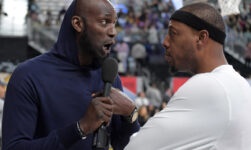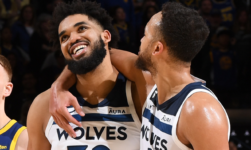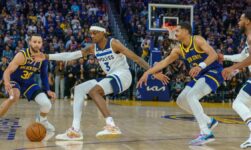With respect to 2008, the year they drafted Stephen Curry, and 2015, the year they actually won their first NBA championship in 40 years, one could argue, quite convincingly, that 2012 was the single-most-important year in Golden State Warriors history.
First and foremost, that was the year Curry underwent the now famously successful surgery that finally healed his tissue-paper right ankle, which was threatening to derail, if not altogether end his career, which in turn would’ve killed the Warriors’ dynasty before it was even born.
In addition, 2012 was the year Golden State drafted Draymond Green, who outside of Curry is the player most responsible for the Warriors becoming the Warriors. Over the years, Green has been showered with appropriate praise, as have, obviously, the dynastic contributions of Curry, Klay Thompson, Andre Iguodala and Steve Kerr, and subsequently Kevin Durant. All those guys could end up with, or will at least be worthy of, a statue outside the Chase Center one day.
On every great team, however, there is a forgotten hero, a clock-punching dirty-worker happy to exist in the shadows of his shinier teammates, and for the Warriors that man was, and forever will be, Andrew Bogut, who also came to Golden State in that charmed 2012 year, and who last week officially retired from professional basketball.
“The decision hasn’t been an easy one, but I think it is the right decision,” Bogut said on his new podcast. “The decision that I made and where I will be signing for next season is absolutely nowhere. I will be retiring from professional basketball, effective immediately.”
That was it. No frills. No look-at-me Players’ Tribune self tribute. Just a simple, straight-to-the-point, workmanlike statement befitting a player and man who never sought the spotlight over parts of 14 NBA seasons. The only reason Bogut needed to announce his retirement at all, frankly, was for international intrigue.
Specifically, Australians — and Bogut himself — were hoping he would hang on long enough to play for his home country in the 2021 Olympics, which will not happen. Bogut said his body has been “hanging by a thread” since 2018, and that over the past two years just getting out of bed had become a challenge.
On the NBA radar, Bogut’s retirement was, at best, a blip. Since 2015-16, his last full season with the Warriors, he’d played in just 61 NBA games with four different teams, largely disappearing from our stateside consciousness as he was winning league MVP for the Sydney Kings in Australia.
Bogut was never that kind of star in the NBA. In fact, as the No. 1 overall pick in a draft that included Chris Paul, you could, on paper, attempt to make the case that his career was something of a disappointment, at least relatively. He never made an All-Star team. He averaged fewer than 10 points a game for his career.
You could say these things, but you would be wildly wrong.
When healthy, Bogut was exactly what he was supposed to be: elite defender, brilliant passer, high-IQ player and overall giant human being. In Milwaukee, few of us paid proper attention to him; we tend not to appreciate non-box-score big men unless we can romanticize their roles within a championship context, even when they lead the league in blocks per game, as Bogut did in 2010-11, or make third-team All-NBA, as he did in 2009-10.
The Warriors — an inept defensive franchise in dire need of a defensive makeover, while also outfitted with a nucleus of rising stars around which a non-centerpiece center like Bogut could orbit — eventually provided that championship context. It was, as they say, a perfect marriage, arranged as it was by a controversial divorce with fan-favorite Monta Ellis, who went back to Milwaukee in a transaction that came with the added benefit of clarifying Curry’s leading-man status moving forward.
“… We knew we needed to get a defensive anchor at center,” current Atlanta Hawks president and GM Travis Schlenk, who was working in the Golden State front office at the time, told CBS Sports. “We were trying to change the way we played. We wanted to get bigger. Tougher. We weren’t getting anywhere just trying to outscore teams. So getting Bogut was a big part of that deal.
“.. People forget how big Bogut was in winning that first championship,” Schlenk continued. “That’s where the defensive part of the equation really started to change. Sitting here today, I can’t say that trade was more about giving Steph the team or getting that defensive anchor. It was both.”
Last week, Warriors GM Bob Myers, who was the assistant GM to Larry Riley in 2012, echoed Schlenk’s sentiments while reflecting on the trade that brought Bogut to Golden State and his esteemed place in Warriors history.
“I want to congratulate Andrew Bogut for his time with us and thrilled for him on a tremendous career,” Myers said. “Obviously a part of a championship team for us, helped us get back to kind of a place of prominence that we hadn’t been in a long time, and he was one of the initial moves — I was an assistant GM — that Larry Riley made. I’ll never forget that transaction and what he meant to our team and our fans.”
Speaking as a Northern California kid who grew up on the Run TMC Warriors, I, too, will never forget that transaction. In my mind, Bogut changed the Warriors as much as Curry, if not more. Hear me out now: I’m obviously not suggesting Bogut was anywhere near the player Curry has been. I’m simply saying he changed the Warriors more.
Curry lights up scoreboards, yes, but the Warriors have long been synonymous with scoring. It’s a big reason why their crowds were always among the most raucous in the league, even when they were losing 50-plus games a year. They were always great theatre — a Nellie-balling, We-Believing, UTEP two-stepping fireworks show that could hang 120 on you any night.
But they’d give up 130.
In that way, Curry, as spectacular as he was and is, felt familiar, an updated version of the old Warriors, whereas Bogut felt like a new kind of hope. Mark Jackson, deservedly, gets a lot of credit for changing the defensive mindset in Golden State, but the Warriors’ defense ranked 26th in Jackson’s first season. It wasn’t until 2012-13, the season Bogut arrived, that they shot up to 12th. That was not a coincidence.
Remember, this was before Iguodala was on the team, and before Green was a starter, and still the Warriors registered an elite 99.2 defensive rating with Bogut on the floor in the 2013 playoffs, when they officially put themselves on the map by upsetting the third-seeded Nuggets before putting an honest second-round scare into to the Spurs. Meanwhile, when Bogut sat in those playoffs, the Warriors’ defensive rating fell by 6.2 points per 100 possessions, and overall they were 12.9 points per 100 better with Bogut on the floor, an impact that trailed only Thompson and Curry.
“Bogut was awesome that whole year,” Darren Erman, who served as Jackson’s top defensive assistant on that Warriors team, told CBS Sports. “Go back and look at Game 6 against Denver, the clincher. Bogut won us that game. He was such a massive force.”
Indeed, Bogut posted 14 points and 21 rebounds in that game as the Warriors held Denver, the fifth-ranked offense in the NBA that season, to 88 points on 34-percent shooting. For the series, Denver — which shot a fifth-best 47.3 percent from the field in the regular season — shot just 43.8 percent from the field, which would’ve ranked 24th league-wide in the regular season.
“Bogut really knew how to drop,” George Karl, who coached that Nuggets team, told CBS Sports. “That was a huge factor. So he dropped on our penetration, and he had great timing as a shot blocker, so that pushes us out of the paint, and we weren’t a good 3-point shooting team, especially with [Danilo] Gallinari injured. So that’s exactly what [the Warriors] wanted. Turn it into a shooting contest, and they’re going to win that every time.
“Our strength was getting into the lane with our speed and finishing or getting to the [free throw] line, and Bogut just had a knack for forcing you back out to the perimeter,” Karl continued. “And the thing was, they were solid on the perimeter, too. They could switch everything and they played really hard, so that cut off a lot of actions right there, and with Bogut dropping on pick and roll, we had to go into more of an isolation game to try to get to the rim. So that slowed us down, and again, we were a fast team. So a lot of things just got out of whack. … Bogut was behind it all for them.”
By the time the Warriors won the 2015 championship, they were the top-ranked defense in the league. Yes, by that time Green was emerging as arguably the most important defender of the decade, Thompson had grown into a legit perimeter stopper and Iguodala, who will go down as one of the best defenders of his generation, had defected from Denver. But Bogut, always the one left out of the conversation, was still wreaking his havoc.
That season, the Warriors allowed opponents to convert just 58.6 percent of their defended shots at the rim, which ranked third in the league, per NBA.com. Nobody was more responsible for that number than Bogut, who, as all the great rim protectors do, altered as many shots as he actually blocked while holding opponents to a remarkable 44.8 percent clip on defended shots at the rim during the regular season, the best mark in the league among players who defended at least 200 such shots.
In the playoffs, that number remained elite at 46.1 percent. For reference on just how gaudy a statistic that is, Rudy Gobert, in his two Defensive Player of the Year campaigns, defended shots at the rim at a 51.4 and 51.9 percent clip, respectively. Bogut kept it up in the 2015-16 playoffs, defending shots at the rim at a 45.9 percent clip.
Also, Bogut was a lot more than just a defender. He developed great chemistry with Curry as a roller. He had push shots and a pretty sweet jump hook with either hand. In the aforementioned 2013 series vs. Denver, he delivered one of the nastiest dunks you’ll ever see from a seven-footer.
Most of all, Bogut was a special passer. And I don’t use that word lightly. He was special. The Warriors ran a lot of offense through him in the same way the Nuggets run through Nikola Jokic, not just because Bogut could deliver the passes, but because he could anticipate them. That’s the difference between a good passer and a special one. Bogut saw and felt the court like a point guard, one beat ahead as he threw shooters open and rewarded cutters with layups, the perfect hub for Golden State’s dizzying design of off-ball movement. Just take a look at some of these dimes:
“Bogut was the perfect guy to surround with shooters,” Erman said. “We were really tough to guard with his passing and all those guys running around, but then on top of that, when he didn’t have the ball, he just set these bone-crushing screens to get guys open.”
It’s true, Bogut’s role diminished in particular playoff matchups. His free-throw yips were a liability, he was a non-shooter and non-switchable defender in a game that was becoming increasingly tethered to shooting and switching, and most of all, the Warriors had discovered their vaunted Death Lineup, an effective center-less unit that forced opponents into a small-ball game they couldn’t win.
Just know this: In 2014-15, the Death Lineup, with Draymond Green as the de-facto big man, outscored opponents by 15.9 points per 100 possessions, while the starting lineup with Bogut at center, outscored opponents by 20.6 points per 100.
That isn’t to suggest the Death Lineup wasn’t incredible or certainly that it wasn’t more playoff-conducive. It’s just a reminder to never speak of Andrew Bogut as a peripheral part of everything the Warriors became. He was central to all of it. He was the guy Steve Kerr switched onto Tony Allen to swing the Memphis series in 2015. He was the guy who had the Warriors playing at a 97.9 defensive rating during his minutes in their NBA record 73-win season. The bottom line is that from 2012-16, in regular-season games that Bogut started alongside Curry, Green and Thompson, the Warriors were 107-14.
Yes, he needed those three guys to be his best. But they needed him, too, a fact perhaps equally evidenced by the losses they suffered in his absence. When the Warriors were eliminated by the Clippers in the first round of the 2014 playoffs, Bogut didn’t play. Everyone loves to blame the Warriors’ 2016 Finals collapse on the Game 5 suspension of Draymond Green, but it was, in fact, Bogut who missed all but seven minutes of the final three games, all of which the Warriors’ lost.
I’m not here to say the Warriors would’ve won that title had Bogut been available for the last 10 quarters; to be totally fair, the Warriors were murdered in Bogut’s limited minutes through the first four games of that series. What I am saying is Game 5 was tied at halftime before Bogut went down with a knee injury in the opening minutes of the third quarter, and the Cavs, who now didn’t have Bogut or Green to deal with, proceeded to outscore Golden State by 15 points in the second half of a game that probably was, in hindsight, the Warriors’ best chance to close out that series.
Either way, Bogut’s presence, and absence were always felt in his time with the Warriors, who spent damn near four decades chasing their next great big man after the departure of Hall of Famer Nate Thurmond in 1974. For a minute, Chris Webber was supposed to be that guy. Joe Smith looked like a superstar on paper. They took a shot with Erick Dampier. Let’s not get started on Adonal Foyle, Andris Biedrins or, for heaven’s sake, Todd Fuller, whom the Warriors drafted two spots ahead of Kobe Bryant in 1996.
Finally, they got Bogut. He wasn’t, by a long shot, as dominant as Thurmond or Wilt Chamberlain, the two greatest big men in Warriors history. But he was the right player, at the right time, for the right team, and his place in Warriors history is absolutely secure. Even if you’ll almost never hear anyone talking about it.






